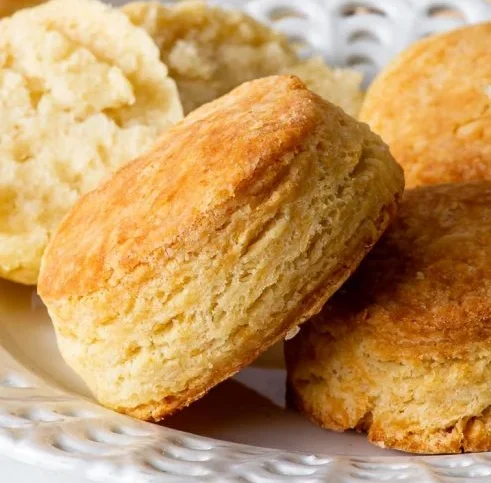Detailed Recipe and Information
Introduction:
If you’re searching for a gluten-free recipe for fluffy and tender buttermilk biscuits, look no further! This Southern-style gluten-free buttermilk biscuit recipe is easy to make, delicious, and comes with options for dairy-free and vegan modifications. Whether you’re craving a breakfast biscuit or a savory side for dinner, these biscuits will satisfy your taste buds without compromising on texture or flavor.
Biscuits are a staple in Southern cuisine, known for their flakiness and buttery taste. For those who have gone gluten-free, finding the perfect biscuit can be challenging. But with this recipe, you can enjoy the same traditional Southern biscuits in a gluten-free form. Plus, there’s no need to worry if you’re dairy or egg-free, as this recipe offers substitutions to meet your dietary needs.
How to Make Gluten-Free Buttermilk Biscuits (Step-by-Step Guide):
Step 1: Preheat Your Oven
Preheat the oven to 450°F. It’s important to start with a fully heated oven to ensure that the biscuits bake evenly and rise properly.
Step 2: Prepare Your Ingredients
- Butter: Cut the butter into small pieces and place it in the freezer for about 10 minutes to chill. This step ensures that the butter remains cold, which is crucial for creating flaky biscuits. If you’re making dairy-free biscuits, substitute butter with a vegan-friendly option like Smart Balance or Earth Balance.
- Buttermilk: If you don’t have buttermilk on hand, make your own by mixing 1 tablespoon of white vinegar or lemon juice with a cup of milk (or dairy-free milk). Let this sit for 5-10 minutes in the refrigerator to stay cold.
Step 3: Mix Dry Ingredients
In a large bowl, combine 2 cups of gluten-free all-purpose flour (ensure it contains xanthan gum, like Pillsbury Gluten-Free), 1 tablespoon of gluten-free baking powder, 1 teaspoon of salt, and 2 tablespoons of granulated sugar. Whisk the dry ingredients together to ensure they’re evenly distributed.
Step 4: Cut in the Butter
Use a pastry cutter or fork to cut the chilled butter (or vegan substitute) into the flour mixture. Keep cutting until the mixture resembles small peas. This is key to achieving the right flaky texture in your biscuits.
Step 5: Add Buttermilk and Egg
Add the prepared buttermilk and whisked egg to the flour mixture. Stir gently until a soft dough forms. If you’re egg-free, use an egg replacer like Bob’s Red Mill Gluten-Free Egg Replacer. Be careful not to overmix the dough, as this can result in tough biscuits.
Step 6: Shape the Dough
Lightly dust a sheet of parchment paper with gluten-free flour, then place the dough on top. Dust the top of the dough with another tablespoon of flour, and gently fold the dough over itself twice. Avoid overworking the dough to maintain its light and fluffy texture.
Step 7: Cut the Biscuits
Use a biscuit cutter or the mouth of a glass to cut out 2-inch rounds from the dough. Do not twist the cutter, as this can seal the edges and prevent the biscuits from rising properly. Reform the remaining dough into a round and cut additional biscuits until all dough is used.
Step 8: Bake the Biscuits
Place the biscuits on a greased cast iron skillet or baking sheet. Bake them for 15-20 minutes, or until they’re golden brown on top. Keep an eye on the biscuits as baking times can vary by oven.
Step 9: Serve Warm
Brush the warm biscuits with melted butter and serve them immediately. Whether you top them with jam, honey, or enjoy them plain, these biscuits are best when warm and fresh out of the oven.
Tips & Tricks for Perfect Gluten-Free Biscuits:
- Flour Matters: Use a gluten-free all-purpose flour blend that contains xanthan gum for best results. Some popular options include Pillsbury Gluten-Free Flour and Bob’s Red Mill Gluten-Free Cup for Cup Flour. If your flour does not contain xanthan gum, be sure to add it.
- Don’t Overmix: Overmixing the dough can lead to tough biscuits. Gently mix until just combined to preserve a light and flaky texture.
- Chill the Butter: Cold butter creates steam during baking, which helps the biscuits rise and creates flaky layers.
- Freezing Option: Flash freeze unbaked biscuits on a parchment-lined baking sheet for 30 minutes, then store them in a freezer-safe bag. When ready to bake, pop the frozen biscuits in the oven and bake for 15-20 minutes at 450°F.
Flour Guide for Gluten-Free Biscuits:
Not all gluten-free flours are created equal, and the type of flour blend you use can affect your biscuits’ texture. Some blends contain sorghum flour, which produces a denser dough. For best results, stick to a blend that contains rice flour, like Pillsbury Gluten-Free Flour.
Dairy-Free and Vegan Modifications:
For dairy-free biscuits, use a dairy-free butter alternative such as Smart Balance and substitute regular milk with almond, cashew, or coconut milk. To make them egg-free and vegan, use an egg replacer like Bob’s Red Mill Gluten-Free Egg Replacer.
Additional Notes on Ingredients:
- Buttermilk Substitute: For a dairy-free version, you can use almond, cashew, or coconut milk and add vinegar to create a buttermilk substitute.
- Egg Substitute: If you’re egg-free or vegan, try using Bob’s Red Mill Gluten-Free Egg Replacer. These substitutes maintain the biscuit’s texture without compromising on flavor


